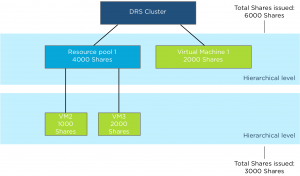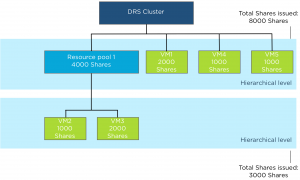One of most frequent questions I receive is about mixing resource pools and virtual machines at the same hierarchical level. In almost all of the cases we recommend to commit to one type of child objects. Either use resource pools and place virtual machines within the resource pools or place only virtual machines at that hierarchical level. The main reason for this is how resource shares work.
Shares determine the relative priority of the child-objects (virtual machines and resource pools) at the same hierarchical level and decide how excess of resources (total system resources – total Reservations) made available by other virtual machines and resource pools are divided.
Shares are level-relative, which means that the number of shares is compared between the child-objects of the same parent. Since, they signify relative priorities; the absolute values do not matter, comparing 2:1 or 20.000 to 10.000 will have the same result.
Lets use an example to clarify. In this scenario the DRS cluster (root resource pool) has two child objects, resource pool 1 and a virtual machine 1. The DRS cluster issues shares amongst its children, 4000 shares issued to the resource pool, 2000 shares issued to the virtual machine. This results in 6000 shares being active on that particular hierarchical level.

During contention the child-objects compete for resources as they are siblings and belong to the same parent. This means that the virtual machine with 2000 shares needs to compete with the resource pool that has 4000 shares. As 6000 shares are issued on that hierarchical level, the relative value of each child entity is (2000 of 6000 shares) = 33% for the virtual machine and (4000 shares of 6000=66%) for the resource pool.
The problem with this configuration is that the resource pool is not only a resource consumer but also a resource provider. So that it must claim resources on behalf of its children. Expanding the first scenario, two virtual machines are placed inside the resource pool.

The Resource Pool issues shares amongst its children, 1000 shares issued to virtual machine 2 (VM2) and 2000 shares issued to virtual machine 3 (VM3). This results in 3000 shares being active on that particular hierarchical level.
During contention the child-objects compete for resources as they are siblings and belong to the same parent which is the resource pool. This means that VM2 owning 1000 shares needs to compete with VM3 that has 2000 shares. As 3000 shares are issued on that hierarchical level, the relative value of each child entity is (1000 of 3000 shares) = 33% for VM2 and (2000 shares of 3000=66%) for VM3.
As the resource pool needs to compete for resources with the virtual machine on the same level, the resource pool can only obtain 66% of the cluster resources. These resources are divided between VM2 and VM3. That means that VM2 can obtain up to 22% of the cluster resources (1/3 of 66% of the total cluster resources is 22%).
Forward to scenario 3, two additional virtual machines are created and are on the same level as Resource Pool 1 and virtual machine 1. The DRS cluster issues 1000 shares to VM4 and 1000 shares to VM5.

As the DRS cluster issued an additional 2000 shares, the total issued shares is increased to 8000 shares. Resulting in dilution of the relative share values of Resource Pool 1 and VM1. Resource pool 1 now owns 4000 shares of a total 8000 bringing the relative value down from 66% to 50%. VM1 owns 2000 shares of 8000, bringing its value down to 25%. Both VM4 and VM5 own each 12.5% of shares.
As resource pool 1 provides resources to its child-object VM2 and VM3, fewer resources are divided between VM2 and VM3. That means that in this scenario VM2 can obtain up to 16% of the cluster resources (1/3 of 50% of the total cluster resources is 16%). Introducing more virtual machines to the same sibling level as the Resource Pool 1, will dilute the resources available to virtual machines inside Resource Pool 1.
This is the reason why we recommend to commit to a single type of entity at a specific sibling level. If you create resource pools, stick with resource pools at that level and provision virtual machines inside the resource pool.
Another fact is that a resource pool receives shares similar to a 4-vcpu 16GB virtual machine. Resulting in a default share value of 4000 shares of CPU and 163840 shares of memory when selecting Normal share value level. When you create a monster virtual machine and place it next to the resource pool, the resource pool will be dwarfed by this monster virtual machine resulting in resource starvation.
Note: Shares are not simply a weighting system for resources. All scenarios to demonstrate way shares work are based on a worst-case scenario situation: every virtual machine claims 100% of their resources, the system is overcommitted and contention occurs. In real life, this situation (hopefully) does not occur very often. During normal operations, not every virtual machine is active and not every active virtual machine is 100% utilized. Activity and amount of contention are two elements determining resource entitlement of active virtual machines. For ease of presentation, we tried to avoid as many variable elements as possible and used a worst-case scenario situation in each example.
So when can it be safe to mix and match virtual machines and resource pools at the same level? When all child-objects are configured with reservation equal to their configuration and limits, this result in an environment where shares are overruled by reservation and no opportunistic allocation of resources exist. But this designs introduces other constraints to consider.
Hi Frank,
Thank you for the post. I understand the drawbacks of “introducing more virtual machines to the same sibling level as the Resource Pool 1”, but there is one thing: why is this a different scenario than introducing more _resource pools_ to the same sibling level?
As far as I see it, the exact same thing is going to happen if I add more resource pools to the first level. What am I missing?
Thanks,
Attila